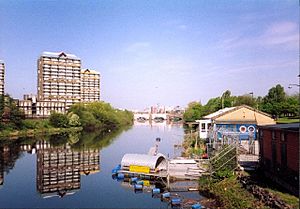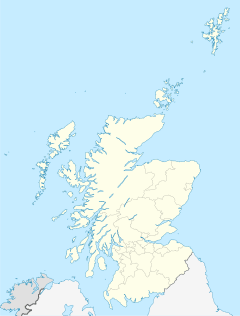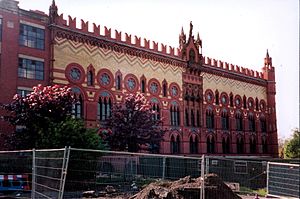Calton, Glasgow facts for kids
Quick facts for kids Calton
|
|
|---|---|
| OS grid reference | NS603645 |
| Council area | |
| Lieutenancy area |
|
| Country | Scotland |
| Sovereign state | United Kingdom |
| Post town | GLASGOW |
| Postcode district | G40 |
| Dialling code | 0141 |
| Ambulance | Scottish |
| EU Parliament | Scotland |
| UK Parliament |
|
| Scottish Parliament |
|

Calton (which means "the hazel wood" in Scottish Gaelic, Scottish Gaelic: A' Challtainn, and is called Caltoun in Scots, Scots: Caltoun) is a well-known area in Glasgow, Scotland. People often call it The Calton. It is located north of the River Clyde and just east of Glasgow's city centre.
Calton is famous for its lively Barras street market. It is also home to the Barrowland Ballroom, which is one of Glasgow's most important places for live music. The area is roughly shaped like a trapezoid. It is bordered by the River Clyde to the south.
Exploring Calton's Past
Calton used to be a special kind of town called a Burgh of Barony. This meant it had its own local government. It was a burgh from 1817 until 1846. In 1846, Calton became part of the larger City of Glasgow.
The land where Calton now stands was once called Blackfaulds. This land originally belonged to the Archbishop of Glasgow. However, in 1587, it became property of The Crown (the King or Queen). In 1705, the owner, John Walkinshaw, started to divide and rent out parts of Blackfaulds. This is how the old village of Calton began to grow.
In 1817, Calton was officially made a Burgh. During its time as an independent burgh, Calton had four leaders called Provosts:
- Robert Struthers (1817-1818)
- Nathaniel Stevenson (1818-1839)
- Robert Bartholomew (1839-1843)
- William Bankier (1843-1846)
The Calton Weavers' Story
Calton was once very famous for its weaving industry. Weavers made cloth using looms. On June 30, 1787, many Calton weavers met on Glasgow Green. They were upset because their wages had dropped. This happened because cheaper textiles were being brought in from other countries.
Most of the weavers decided to go on strike. This meant they stopped working to demand better pay. However, some weavers accepted lower wages and kept working. The situation became very tense on September 3, 1787. Violence broke out when striking weavers tried to take materials from those who were still working.
The military was called in to stop the fighting. Soldiers from the 39th Regiment of Foot opened fire on the protesting weavers. Six men were killed during this event. These men were later called 'martyrs' by the local community. Some of them were buried in the Calton Cemetery on London Road. Their families could not afford headstones for their graves. However, about a hundred years later, a memorial was built to remember their actions and sacrifice.
Community Life in Calton
Calton is a close-knit community with a strong sense of local identity. Like many older city areas, it has faced challenges over the years. However, local groups and residents work hard to improve the area. Many homes in Calton are managed by Housing Associations. These organizations help provide affordable places to live for people in the community.
The area has a rich history, including its past as a center for the weaving industry. This history is still remembered and celebrated by the people of Calton.
Images for kids




